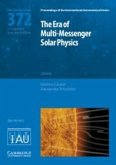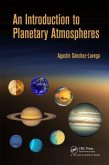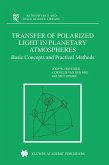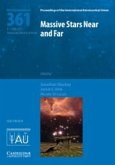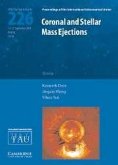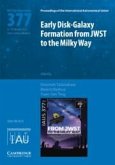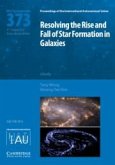Dynamics of Solar and Stellar Convection Zones and Atmospheres (Iau S365)
Herausgeber: Getling, Alexander V; Kitchatinov, Leonid L
Dynamics of Solar and Stellar Convection Zones and Atmospheres (Iau S365)
Herausgeber: Getling, Alexander V; Kitchatinov, Leonid L
- Gebundenes Buch
- Merkliste
- Auf die Merkliste
- Bewerten Bewerten
- Teilen
- Produkt teilen
- Produkterinnerung
- Produkterinnerung
Impressive events of magnetic energy release, such as solar and stellar flares and coronal mass ejections, take place in the atmospheric layers above a star's photosphere. These magnetic-activity events are closely related to the dynamics of subsurface convection zones inside the star. IAU Symposium 365 was devoted to observational and theoretical aspects of solar and stellar hydrodynamics and magnetohydrodynamics, both global and local, including numerical studies. The last few decades have been marked by substantial progress in our understanding of the physics of internal and external…mehr
Andere Kunden interessierten sich auch für
![The Era of Multi-Messenger Solar Physics (Iau S372) The Era of Multi-Messenger Solar Physics (Iau S372)]() The Era of Multi-Messenger Solar Physics (Iau S372)163,99 €
The Era of Multi-Messenger Solar Physics (Iau S372)163,99 €![An Introduction to Planetary Atmospheres An Introduction to Planetary Atmospheres]() Agustin Sanchez-LavegaAn Introduction to Planetary Atmospheres154,99 €
Agustin Sanchez-LavegaAn Introduction to Planetary Atmospheres154,99 €![Transfer of Polarized Light in Planetary Atmospheres Transfer of Polarized Light in Planetary Atmospheres]() Joop W. HovenierTransfer of Polarized Light in Planetary Atmospheres120,99 €
Joop W. HovenierTransfer of Polarized Light in Planetary Atmospheres120,99 €![Massive Stars Near and Far (Iau S361) Massive Stars Near and Far (Iau S361)]() Massive Stars Near and Far (Iau S361)163,99 €
Massive Stars Near and Far (Iau S361)163,99 €![Coronal and Stellar Mass Ejections (Iau S226) Coronal and Stellar Mass Ejections (Iau S226)]() Kenneth Dere / Jingxiu Wang / Yihua Yan (eds.)Coronal and Stellar Mass Ejections (Iau S226)95,99 €
Kenneth Dere / Jingxiu Wang / Yihua Yan (eds.)Coronal and Stellar Mass Ejections (Iau S226)95,99 €![Early Disk-Galaxy Formation from Jwst to the Milky Way (Iau S377) Early Disk-Galaxy Formation from Jwst to the Milky Way (Iau S377)]() Early Disk-Galaxy Formation from Jwst to the Milky Way (Iau S377)153,99 €
Early Disk-Galaxy Formation from Jwst to the Milky Way (Iau S377)153,99 €![Resolving the Rise and Fall of Star Formation in Galaxies (Iau S373) Resolving the Rise and Fall of Star Formation in Galaxies (Iau S373)]() Resolving the Rise and Fall of Star Formation in Galaxies (Iau S373)136,99 €
Resolving the Rise and Fall of Star Formation in Galaxies (Iau S373)136,99 €-
-
-
Impressive events of magnetic energy release, such as solar and stellar flares and coronal mass ejections, take place in the atmospheric layers above a star's photosphere. These magnetic-activity events are closely related to the dynamics of subsurface convection zones inside the star. IAU Symposium 365 was devoted to observational and theoretical aspects of solar and stellar hydrodynamics and magnetohydrodynamics, both global and local, including numerical studies. The last few decades have been marked by substantial progress in our understanding of the physics of internal and external processes in the Sun and solar-type stars, but the scientific communities making this progress have not traditionally worked closely together. This symposium, delayed due to the COVID pandemic, brought together specialists in the physics of convection zones and atmospheres, to stimulate the emergence of new ideas and to develop new techniques in this dynamic field of active research.
Hinweis: Dieser Artikel kann nur an eine deutsche Lieferadresse ausgeliefert werden.
Hinweis: Dieser Artikel kann nur an eine deutsche Lieferadresse ausgeliefert werden.
Produktdetails
- Produktdetails
- Verlag: Cambridge University Press
- Seitenzahl: 400
- Erscheinungstermin: 17. April 2025
- Englisch
- ISBN-13: 9781108490771
- ISBN-10: 1108490778
- Artikelnr.: 70829143
- Herstellerkennzeichnung
- Libri GmbH
- Europaallee 1
- 36244 Bad Hersfeld
- gpsr@libri.de
- Verlag: Cambridge University Press
- Seitenzahl: 400
- Erscheinungstermin: 17. April 2025
- Englisch
- ISBN-13: 9781108490771
- ISBN-10: 1108490778
- Artikelnr.: 70829143
- Herstellerkennzeichnung
- Libri GmbH
- Europaallee 1
- 36244 Bad Hersfeld
- gpsr@libri.de
Section 1. Solar and Stellar Convection: Effects of rotation and surface
forcing on deep stellar convection zones P. J. Käpylä; Analyzing magnetic
network and its variations over Solar Cycles 23, 24 and 25 based on
magnetic power spectra Y. Luo, J. Jiang and R. Wang; Imaging stellar
surface features with optical interferometry X. Haubois; Section 2.
Differential Rotation and Meridional Circulation: Differential rotation of
the solar chromosphere using multidecadal Ca II K spectroheliograms D. K.
Mishra et al.; A frequency-dependent method for measuring the Sun's
interior meridional circulation R. Chen and J. Zhao; Probing the Sun's near
surface shear layer using HMI spherical harmonic coefficients S. C.
Tripathy, K. Jain, S. Kholikov and R. Komm; Rotational shear in the low
photosphere of the Sun T. Corbard, M. Faurobert et al.; Near-surface shear
layer of solar rotation: origin and significance L. Kitchatinov; The
near-surface shear layer (NSSL) of the Sun: a theoretical model A. R.
Choudhuri and B. K. Jha; Differential rotation of stars from spot transit
mapping: dependence on rotation period and effective temperature A. Araújo
and A. Valio; Short and long term spot evolution on EI Eri L. Kriskovics et
al.; Magnetic activity under tidal influences in the 2+2 hierarchical
quadruple system V815 Herculis Zs. K¿vári et al.; Section 3. Global dynamo.
Solar and Stellar Activity Cycles: Recent developments in the
Babcock-Leighton solar dynamo theory B. B. Karak; Nonlinear and stochastic
mechanisms of the solar cycle and their implications for the cycle
prediction J. Jiang; A new generation of solar dynamo model and its
application to explore the stellar magnetic cycle Z. Zhang; Resonance and
stellar dynamos D. Sokoloff, E. Yushkov and A. Serenkova; The role of
nonlinear toroidal flux loss due to flux emergence in the long-term
evolution of the solar cycle A. Biswas; Dominating active regions in the
minima of solar activity R. A. Suleymanova and V. I. Abramenko; Solar cycle
variability induced by stochastic fluctuations of BMR properties and at
different amounts of dynamo supercriticality Pawan Kumar; Exploring the
predictability of the solar cycle from the polar field rise rate: Results
from observations and simulations A. Biswas; The North-South asymmetry of
the number and magnetic fluxes of active regions of different
magneto-morphological types in cycles 23 and 24 A. Zhukova; Prognostic
opportunity of the shifted correlation Between Wolf numbers and their time
derivatives S. V. Starchenko and S. V. Yakovleva; Chromosphere activity:
relations with solar cycles S. Koutchmy and E. Tavabi; Modelling the
rotation dependence of cycle variability in sun-like stars: Answering why
only slowly rotating stars produce grand minima V. Vashishth; On origin of
active/inactive branches on moderate rotating solar analogs V. V. Pipin;
Section 4. Helioseismology and Asteroseismology: Recent progress in
time-distance helioseismology: meridional circulation, far-side imaging,
and sunquakes R. Chen and J. Zhao; Convection, rotation, and magnetic
activity of solar-like stars from asteroseismology S. Mathur; Solar
inertial modes L. Gizon et al.; A 2D model for the excitation of the
linearly stable inertial modes of the Sun by turbulent convection J.
Philidet and L. Gizon; Temporal variation of solar equatorial Rossby modes
with azimuthal orders 6 <= m <= 10 B. Lekshmi et al.; Observational study
of Reynolds stresses associated with solar inertial modes Y. Mandowara et
al.; Probing the superadiabaticity of the solar convection zone with
inertial modes P. Dey et al.; Effects of small-scale magnetic fields in the
photosphere on surface effects for solar-like stars G. Lin, Y. Li, T. Wu
and S. Jie; The effect of Coulomb interactions on acoustic oscillations in
the outer layers of low-mass stars A. Brito and I. Lopes; Section 5. Local
Processes of Ma
forcing on deep stellar convection zones P. J. Käpylä; Analyzing magnetic
network and its variations over Solar Cycles 23, 24 and 25 based on
magnetic power spectra Y. Luo, J. Jiang and R. Wang; Imaging stellar
surface features with optical interferometry X. Haubois; Section 2.
Differential Rotation and Meridional Circulation: Differential rotation of
the solar chromosphere using multidecadal Ca II K spectroheliograms D. K.
Mishra et al.; A frequency-dependent method for measuring the Sun's
interior meridional circulation R. Chen and J. Zhao; Probing the Sun's near
surface shear layer using HMI spherical harmonic coefficients S. C.
Tripathy, K. Jain, S. Kholikov and R. Komm; Rotational shear in the low
photosphere of the Sun T. Corbard, M. Faurobert et al.; Near-surface shear
layer of solar rotation: origin and significance L. Kitchatinov; The
near-surface shear layer (NSSL) of the Sun: a theoretical model A. R.
Choudhuri and B. K. Jha; Differential rotation of stars from spot transit
mapping: dependence on rotation period and effective temperature A. Araújo
and A. Valio; Short and long term spot evolution on EI Eri L. Kriskovics et
al.; Magnetic activity under tidal influences in the 2+2 hierarchical
quadruple system V815 Herculis Zs. K¿vári et al.; Section 3. Global dynamo.
Solar and Stellar Activity Cycles: Recent developments in the
Babcock-Leighton solar dynamo theory B. B. Karak; Nonlinear and stochastic
mechanisms of the solar cycle and their implications for the cycle
prediction J. Jiang; A new generation of solar dynamo model and its
application to explore the stellar magnetic cycle Z. Zhang; Resonance and
stellar dynamos D. Sokoloff, E. Yushkov and A. Serenkova; The role of
nonlinear toroidal flux loss due to flux emergence in the long-term
evolution of the solar cycle A. Biswas; Dominating active regions in the
minima of solar activity R. A. Suleymanova and V. I. Abramenko; Solar cycle
variability induced by stochastic fluctuations of BMR properties and at
different amounts of dynamo supercriticality Pawan Kumar; Exploring the
predictability of the solar cycle from the polar field rise rate: Results
from observations and simulations A. Biswas; The North-South asymmetry of
the number and magnetic fluxes of active regions of different
magneto-morphological types in cycles 23 and 24 A. Zhukova; Prognostic
opportunity of the shifted correlation Between Wolf numbers and their time
derivatives S. V. Starchenko and S. V. Yakovleva; Chromosphere activity:
relations with solar cycles S. Koutchmy and E. Tavabi; Modelling the
rotation dependence of cycle variability in sun-like stars: Answering why
only slowly rotating stars produce grand minima V. Vashishth; On origin of
active/inactive branches on moderate rotating solar analogs V. V. Pipin;
Section 4. Helioseismology and Asteroseismology: Recent progress in
time-distance helioseismology: meridional circulation, far-side imaging,
and sunquakes R. Chen and J. Zhao; Convection, rotation, and magnetic
activity of solar-like stars from asteroseismology S. Mathur; Solar
inertial modes L. Gizon et al.; A 2D model for the excitation of the
linearly stable inertial modes of the Sun by turbulent convection J.
Philidet and L. Gizon; Temporal variation of solar equatorial Rossby modes
with azimuthal orders 6 <= m <= 10 B. Lekshmi et al.; Observational study
of Reynolds stresses associated with solar inertial modes Y. Mandowara et
al.; Probing the superadiabaticity of the solar convection zone with
inertial modes P. Dey et al.; Effects of small-scale magnetic fields in the
photosphere on surface effects for solar-like stars G. Lin, Y. Li, T. Wu
and S. Jie; The effect of Coulomb interactions on acoustic oscillations in
the outer layers of low-mass stars A. Brito and I. Lopes; Section 5. Local
Processes of Ma
Section 1. Solar and Stellar Convection: Effects of rotation and surface
forcing on deep stellar convection zones P. J. Käpylä; Analyzing magnetic
network and its variations over Solar Cycles 23, 24 and 25 based on
magnetic power spectra Y. Luo, J. Jiang and R. Wang; Imaging stellar
surface features with optical interferometry X. Haubois; Section 2.
Differential Rotation and Meridional Circulation: Differential rotation of
the solar chromosphere using multidecadal Ca II K spectroheliograms D. K.
Mishra et al.; A frequency-dependent method for measuring the Sun's
interior meridional circulation R. Chen and J. Zhao; Probing the Sun's near
surface shear layer using HMI spherical harmonic coefficients S. C.
Tripathy, K. Jain, S. Kholikov and R. Komm; Rotational shear in the low
photosphere of the Sun T. Corbard, M. Faurobert et al.; Near-surface shear
layer of solar rotation: origin and significance L. Kitchatinov; The
near-surface shear layer (NSSL) of the Sun: a theoretical model A. R.
Choudhuri and B. K. Jha; Differential rotation of stars from spot transit
mapping: dependence on rotation period and effective temperature A. Araújo
and A. Valio; Short and long term spot evolution on EI Eri L. Kriskovics et
al.; Magnetic activity under tidal influences in the 2+2 hierarchical
quadruple system V815 Herculis Zs. K¿vári et al.; Section 3. Global dynamo.
Solar and Stellar Activity Cycles: Recent developments in the
Babcock-Leighton solar dynamo theory B. B. Karak; Nonlinear and stochastic
mechanisms of the solar cycle and their implications for the cycle
prediction J. Jiang; A new generation of solar dynamo model and its
application to explore the stellar magnetic cycle Z. Zhang; Resonance and
stellar dynamos D. Sokoloff, E. Yushkov and A. Serenkova; The role of
nonlinear toroidal flux loss due to flux emergence in the long-term
evolution of the solar cycle A. Biswas; Dominating active regions in the
minima of solar activity R. A. Suleymanova and V. I. Abramenko; Solar cycle
variability induced by stochastic fluctuations of BMR properties and at
different amounts of dynamo supercriticality Pawan Kumar; Exploring the
predictability of the solar cycle from the polar field rise rate: Results
from observations and simulations A. Biswas; The North-South asymmetry of
the number and magnetic fluxes of active regions of different
magneto-morphological types in cycles 23 and 24 A. Zhukova; Prognostic
opportunity of the shifted correlation Between Wolf numbers and their time
derivatives S. V. Starchenko and S. V. Yakovleva; Chromosphere activity:
relations with solar cycles S. Koutchmy and E. Tavabi; Modelling the
rotation dependence of cycle variability in sun-like stars: Answering why
only slowly rotating stars produce grand minima V. Vashishth; On origin of
active/inactive branches on moderate rotating solar analogs V. V. Pipin;
Section 4. Helioseismology and Asteroseismology: Recent progress in
time-distance helioseismology: meridional circulation, far-side imaging,
and sunquakes R. Chen and J. Zhao; Convection, rotation, and magnetic
activity of solar-like stars from asteroseismology S. Mathur; Solar
inertial modes L. Gizon et al.; A 2D model for the excitation of the
linearly stable inertial modes of the Sun by turbulent convection J.
Philidet and L. Gizon; Temporal variation of solar equatorial Rossby modes
with azimuthal orders 6 <= m <= 10 B. Lekshmi et al.; Observational study
of Reynolds stresses associated with solar inertial modes Y. Mandowara et
al.; Probing the superadiabaticity of the solar convection zone with
inertial modes P. Dey et al.; Effects of small-scale magnetic fields in the
photosphere on surface effects for solar-like stars G. Lin, Y. Li, T. Wu
and S. Jie; The effect of Coulomb interactions on acoustic oscillations in
the outer layers of low-mass stars A. Brito and I. Lopes; Section 5. Local
Processes of Ma
forcing on deep stellar convection zones P. J. Käpylä; Analyzing magnetic
network and its variations over Solar Cycles 23, 24 and 25 based on
magnetic power spectra Y. Luo, J. Jiang and R. Wang; Imaging stellar
surface features with optical interferometry X. Haubois; Section 2.
Differential Rotation and Meridional Circulation: Differential rotation of
the solar chromosphere using multidecadal Ca II K spectroheliograms D. K.
Mishra et al.; A frequency-dependent method for measuring the Sun's
interior meridional circulation R. Chen and J. Zhao; Probing the Sun's near
surface shear layer using HMI spherical harmonic coefficients S. C.
Tripathy, K. Jain, S. Kholikov and R. Komm; Rotational shear in the low
photosphere of the Sun T. Corbard, M. Faurobert et al.; Near-surface shear
layer of solar rotation: origin and significance L. Kitchatinov; The
near-surface shear layer (NSSL) of the Sun: a theoretical model A. R.
Choudhuri and B. K. Jha; Differential rotation of stars from spot transit
mapping: dependence on rotation period and effective temperature A. Araújo
and A. Valio; Short and long term spot evolution on EI Eri L. Kriskovics et
al.; Magnetic activity under tidal influences in the 2+2 hierarchical
quadruple system V815 Herculis Zs. K¿vári et al.; Section 3. Global dynamo.
Solar and Stellar Activity Cycles: Recent developments in the
Babcock-Leighton solar dynamo theory B. B. Karak; Nonlinear and stochastic
mechanisms of the solar cycle and their implications for the cycle
prediction J. Jiang; A new generation of solar dynamo model and its
application to explore the stellar magnetic cycle Z. Zhang; Resonance and
stellar dynamos D. Sokoloff, E. Yushkov and A. Serenkova; The role of
nonlinear toroidal flux loss due to flux emergence in the long-term
evolution of the solar cycle A. Biswas; Dominating active regions in the
minima of solar activity R. A. Suleymanova and V. I. Abramenko; Solar cycle
variability induced by stochastic fluctuations of BMR properties and at
different amounts of dynamo supercriticality Pawan Kumar; Exploring the
predictability of the solar cycle from the polar field rise rate: Results
from observations and simulations A. Biswas; The North-South asymmetry of
the number and magnetic fluxes of active regions of different
magneto-morphological types in cycles 23 and 24 A. Zhukova; Prognostic
opportunity of the shifted correlation Between Wolf numbers and their time
derivatives S. V. Starchenko and S. V. Yakovleva; Chromosphere activity:
relations with solar cycles S. Koutchmy and E. Tavabi; Modelling the
rotation dependence of cycle variability in sun-like stars: Answering why
only slowly rotating stars produce grand minima V. Vashishth; On origin of
active/inactive branches on moderate rotating solar analogs V. V. Pipin;
Section 4. Helioseismology and Asteroseismology: Recent progress in
time-distance helioseismology: meridional circulation, far-side imaging,
and sunquakes R. Chen and J. Zhao; Convection, rotation, and magnetic
activity of solar-like stars from asteroseismology S. Mathur; Solar
inertial modes L. Gizon et al.; A 2D model for the excitation of the
linearly stable inertial modes of the Sun by turbulent convection J.
Philidet and L. Gizon; Temporal variation of solar equatorial Rossby modes
with azimuthal orders 6 <= m <= 10 B. Lekshmi et al.; Observational study
of Reynolds stresses associated with solar inertial modes Y. Mandowara et
al.; Probing the superadiabaticity of the solar convection zone with
inertial modes P. Dey et al.; Effects of small-scale magnetic fields in the
photosphere on surface effects for solar-like stars G. Lin, Y. Li, T. Wu
and S. Jie; The effect of Coulomb interactions on acoustic oscillations in
the outer layers of low-mass stars A. Brito and I. Lopes; Section 5. Local
Processes of Ma


